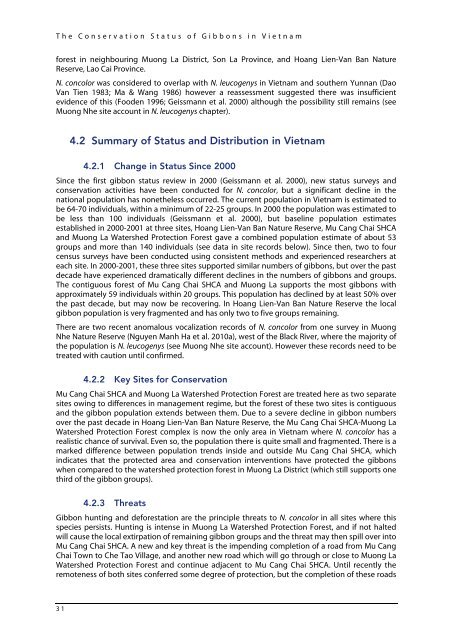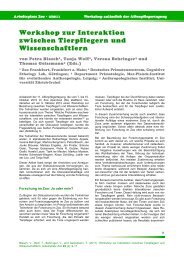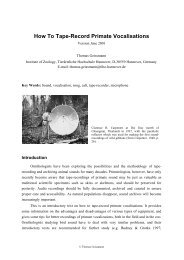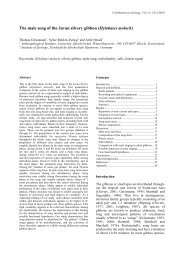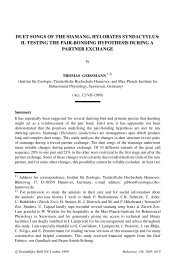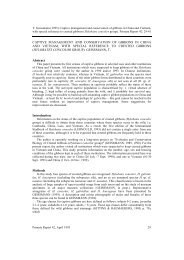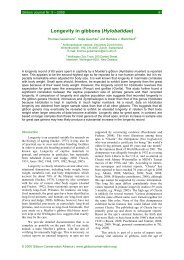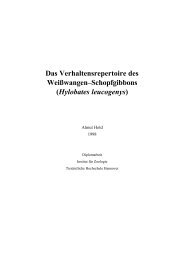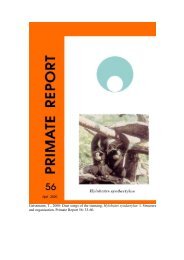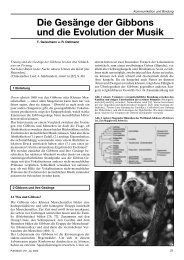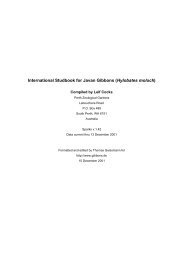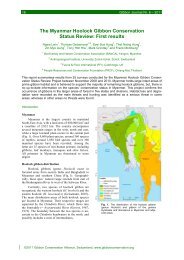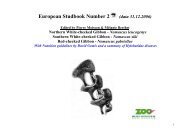Nomascus concolor4 Western Black <strong>Gibbon</strong>Nomascus concolor (Harlan, 1826)Other English names: western black crested gibbon, black gibbon, black crested gibbon,Indoch<strong>in</strong>ese gibbon<strong>Vietnam</strong>ese names: vượn đen, vượn đen tuyềnIUCN Red List Category and Criteria: Critically Endangered A2cd (ver 3.1)2007 <strong>Vietnam</strong> Red Data Book Category and Criteria: Endangered A1cd C2aLegislative status <strong>in</strong> <strong>Vietnam</strong>: Decree 32/2006 ND-CP: 1BCITES: Appendix I4.1 Global <strong>Status</strong> and DistributionNomascus concolor currently has a discont<strong>in</strong>uous distribution over parts <strong>of</strong> south-west Ch<strong>in</strong>a,north-west Laos and north-west <strong>Vietnam</strong>, although over a millenium ago, Nomascus species mayhave occurred over a large area <strong>of</strong> south and central Ch<strong>in</strong>a, north to the Yellow River (Geissmannet al. 2000). Four subspecies <strong>of</strong> Nomascus concolor have been recognised, with three occurr<strong>in</strong>g <strong>in</strong>Ch<strong>in</strong>a (Ma & Wang 1986; Ma et al. 1988; Geissmann 1993, 1994, 1995; Groves 2001; Mootnick &Fan Pengfei 2011). But a recent phylogenetic analysis for the genus Nomascus argues there areonly two subspecies, the nom<strong>in</strong>ate N. c. concolor and N. c. lu, with the latter restricted to Laos (VanNgoc Th<strong>in</strong>h et al. 2010b; Van Ngoc Th<strong>in</strong>h et al. 2010e). Only one rema<strong>in</strong><strong>in</strong>g potentially viablepopulation <strong>of</strong> N. c. lu is known, <strong>in</strong> Nam Kan National Protected Area <strong>in</strong> north-west Laos, whereabout 9 to 14 groups are be<strong>in</strong>g protected by a tourism project and little more is known about thelocal population (Robichaud et al. 2010).Most <strong>of</strong> the global population <strong>of</strong> Nomascus concolor occurs <strong>in</strong> southern and central YunnanProv<strong>in</strong>ce <strong>of</strong> south-west Ch<strong>in</strong>a, <strong>in</strong>clud<strong>in</strong>g the only groups <strong>of</strong> Nomascus known to occur west <strong>of</strong> theMekong River (still sometimes referred to as the sub-species N. c. furgovaster). <strong>The</strong>re was nocomprehensive assessment <strong>of</strong> the total population <strong>of</strong> N. concolor <strong>in</strong> Yunnan Prov<strong>in</strong>ce untilrecently, because field data results varied widely and no consensus could be reached (JiangXuelong et al. 2006). Workshops organized by Yunnan Forestry Bureau and Fauna & FloraInternational to prepare an action plan for this species <strong>in</strong> 2010 and 2011 have enabled the totalpopulation <strong>of</strong> N. concolor <strong>in</strong> Yunnan Prov<strong>in</strong>ce to be estimated at 1,100 to 1,300 <strong>in</strong>dividuals <strong>in</strong> morethan 270 groups. <strong>The</strong> largest known populations are located along two parallel mounta<strong>in</strong> cha<strong>in</strong>s,Wuliangshan and Ailaoshan <strong>in</strong> central Yunnan Prov<strong>in</strong>ce. Surveys <strong>in</strong> 2010 estimated 87 groups <strong>in</strong>Wuliangshan National Nature Reserve (Luo Zhonghua 2010) and 124 groups <strong>in</strong> X<strong>in</strong> P<strong>in</strong>g County <strong>of</strong>Ailaoshan National and County Nature Reserves (X<strong>in</strong> P<strong>in</strong>g Management Bureau <strong>of</strong> AilaoshanNational Nature Reserve 2010). Thirty-n<strong>in</strong>e gibbon groups were recorded <strong>in</strong> Shuang Bai, ChuXiong and Nan Hua Counties <strong>of</strong> Ailaoshan National Nature Reserve <strong>in</strong> 2005 (Chu Xiong PrefectureNature Reserve Management Bureau 2006) and gibbons are known to be distributed <strong>in</strong> otherparts <strong>of</strong> the nature reserve. <strong>The</strong>refore overall the Ailao mounta<strong>in</strong> range appears to hold the largestpopulation <strong>of</strong> N. concolor globally.<strong>Vietnam</strong> supports at most 5% <strong>of</strong> the global population <strong>of</strong> N. concolor. <strong>The</strong> species occurs <strong>in</strong> thenorth <strong>of</strong> the country between the Black and Red Rivers (known locally as Song Da and Song Hongrespectively) (Groves 2001). Reports from west <strong>of</strong> the Black River persist but are unconfirmed(Bleisch et al. 2008b; Nguyen Manh Ha et al. 2010a). Extant populations appear to be restricted totwo locations <strong>in</strong> the Hoang Lien mounta<strong>in</strong> range; a block <strong>of</strong> contiguous forest extend<strong>in</strong>g from MuCang Chai Species and Habitat <strong>Conservation</strong> Area (SHCA), Yen Bai Prov<strong>in</strong>ce, <strong>in</strong>to a watershed30
<strong>The</strong> <strong>Conservation</strong> <strong>Status</strong> <strong>of</strong> <strong><strong>Gibbon</strong>s</strong> <strong>in</strong> <strong>Vietnam</strong>forest <strong>in</strong> neighbour<strong>in</strong>g Muong La District, Son La Prov<strong>in</strong>ce, and Hoang Lien-Van Ban NatureReserve, Lao Cai Prov<strong>in</strong>ce.N. concolor was considered to overlap with N. leucogenys <strong>in</strong> <strong>Vietnam</strong> and southern Yunnan (DaoVan Tien 1983; Ma & Wang 1986) however a reassessment suggested there was <strong>in</strong>sufficientevidence <strong>of</strong> this (Fooden 1996; Geissmann et al. 2000) although the possibility still rema<strong>in</strong>s (seeMuong Nhe site account <strong>in</strong> N. leucogenys chapter).4.2 Summary <strong>of</strong> <strong>Status</strong> and Distribution <strong>in</strong> <strong>Vietnam</strong>4.2.1 Change <strong>in</strong> <strong>Status</strong> S<strong>in</strong>ce 2000S<strong>in</strong>ce the first gibbon status review <strong>in</strong> 2000 (Geissmann et al. 2000), new status surveys andconservation activities have been conducted for N. concolor, but a significant decl<strong>in</strong>e <strong>in</strong> thenational population has nonetheless occurred. <strong>The</strong> current population <strong>in</strong> <strong>Vietnam</strong> is estimated tobe 64-70 <strong>in</strong>dividuals, with<strong>in</strong> a m<strong>in</strong>imum <strong>of</strong> 22-25 groups. In 2000 the population was estimated tobe less than 100 <strong>in</strong>dividuals (Geissmann et al. 2000), but basel<strong>in</strong>e population estimatesestablished <strong>in</strong> 2000-2001 at three sites, Hoang Lien-Van Ban Nature Reserve, Mu Cang Chai SHCAand Muong La Watershed Protection Forest gave a comb<strong>in</strong>ed population estimate <strong>of</strong> about 53groups and more than 140 <strong>in</strong>dividuals (see data <strong>in</strong> site records below). S<strong>in</strong>ce then, two to fourcensus surveys have been conducted us<strong>in</strong>g consistent methods and experienced researchers ateach site. In 2000-2001, these three sites supported similar numbers <strong>of</strong> gibbons, but over the pastdecade have experienced dramatically different decl<strong>in</strong>es <strong>in</strong> the numbers <strong>of</strong> gibbons and groups.<strong>The</strong> contiguous forest <strong>of</strong> Mu Cang Chai SHCA and Muong La supports the most gibbons withapproximately 59 <strong>in</strong>dividuals with<strong>in</strong> 20 groups. This population has decl<strong>in</strong>ed by at least 50% overthe past decade, but may now be recover<strong>in</strong>g. In Hoang Lien-Van Ban Nature Reserve the localgibbon population is very fragmented and has only two to five groups rema<strong>in</strong><strong>in</strong>g.<strong>The</strong>re are two recent anomalous vocalization records <strong>of</strong> N. concolor from one survey <strong>in</strong> MuongNhe Nature Reserve (Nguyen Manh Ha et al. 2010a), west <strong>of</strong> the Black River, where the majority <strong>of</strong>the population is N. leucogenys (see Muong Nhe site account). However these records need to betreated with caution until confirmed.4.2.2 Key Sites for <strong>Conservation</strong>Mu Cang Chai SHCA and Muong La Watershed Protection Forest are treated here as two separatesites ow<strong>in</strong>g to differences <strong>in</strong> management regime, but the forest <strong>of</strong> these two sites is contiguousand the gibbon population extends between them. Due to a severe decl<strong>in</strong>e <strong>in</strong> gibbon numbersover the past decade <strong>in</strong> Hoang Lien-Van Ban Nature Reserve, the Mu Cang Chai SHCA-Muong LaWatershed Protection Forest complex is now the only area <strong>in</strong> <strong>Vietnam</strong> where N. concolor has arealistic chance <strong>of</strong> survival. Even so, the population there is quite small and fragmented. <strong>The</strong>re is amarked difference between population trends <strong>in</strong>side and outside Mu Cang Chai SHCA, which<strong>in</strong>dicates that the protected area and conservation <strong>in</strong>terventions have protected the gibbonswhen compared to the watershed protection forest <strong>in</strong> Muong La District (which still supports onethird <strong>of</strong> the gibbon groups).4.2.3 Threats<strong>Gibbon</strong> hunt<strong>in</strong>g and deforestation are the pr<strong>in</strong>ciple threats to N. concolor <strong>in</strong> all sites where thisspecies persists. Hunt<strong>in</strong>g is <strong>in</strong>tense <strong>in</strong> Muong La Watershed Protection Forest, and if not haltedwill cause the local extirpation <strong>of</strong> rema<strong>in</strong><strong>in</strong>g gibbon groups and the threat may then spill over <strong>in</strong>toMu Cang Chai SHCA. A new and key threat is the impend<strong>in</strong>g completion <strong>of</strong> a road from Mu CangChai Town to Che Tao Village, and another new road which will go through or close to Muong LaWatershed Protection Forest and cont<strong>in</strong>ue adjacent to Mu Cang Chai SHCA. Until recently theremoteness <strong>of</strong> both sites conferred some degree <strong>of</strong> protection, but the completion <strong>of</strong> these roads31
- Page 2: The Conservation Status of Gibbons
- Page 7: The Conservation Status of Gibbons
- Page 10 and 11: A site is defined in this report as
- Page 12 and 13: Abbreviations and Acronymsa.s.l. ab
- Page 14 and 15: carried out in 2000 and 2001. At Ho
- Page 16 and 17: ConclusionsWhile gibbons are afford
- Page 18 and 19: IntroductionChapter 1IntroductionFe
- Page 20 and 21: Introductionexperienced conservatio
- Page 22 and 23: The Conservation Status of Gibbons
- Page 24 and 25: The Conservation Status of Gibbons
- Page 26 and 27: The Conservation Status of Gibbons
- Page 28 and 29: The Conservation Status of Gibbons
- Page 30 and 31: The Conservation Status of Gibbons
- Page 32 and 33: The Conservation Status of Gibbons
- Page 34 and 35: The Conservation Status of Gibbons
- Page 36 and 37: Nomascus nasutusChapter 3Eastern bl
- Page 38 and 39: Nomascus nasutus3 Eastern Black Gib
- Page 40 and 41: Nomascus nasutusrecorded on an ad h
- Page 42 and 43: Nomascus nasutusand field surveys,
- Page 44 and 45: Nomascus concolorChapter 4Western b
- Page 48 and 49: Nomascus concolorwill provide incre
- Page 50 and 51: Nomascus concolorthose in neighbour
- Page 52 and 53: Nomascus concolorDat & Le Minh Phon
- Page 54 and 55: Nomascus leucogenysChapter 5Norther
- Page 56 and 57: Nomascus leucogenys5 Northern White
- Page 58 and 59: Nomascus leucogenys5.3 Nomascus leu
- Page 60 and 61: Nomascus leucogenysNguyen Manh Ha e
- Page 62 and 63: Nomascus leucogenysThe reserve mana
- Page 64 and 65: Nomascus leucogenys5.3.10 Pu Mat Na
- Page 66 and 67: Nomascus leucogenysStatusA 13 day s
- Page 68 and 69: Nomascus leucogenysDuong Anh Tuan 2
- Page 70 and 71: Nomascus sikiChapter 6Southern whit
- Page 72 and 73: Nomascus siki6 Southern White-cheek
- Page 74 and 75: Nomascus siki6.2.5 Priority Conserv
- Page 76 and 77: Nomascus sikithese vagaries, the pa
- Page 78 and 79: Nomascus sikifield records (Le Manh
- Page 80 and 81: Nomascus annamensisChapter 7Norther
- Page 82 and 83: Nomascus annamensis7 Northern Yello
- Page 84 and 85: Nomascus annamensisStatusThis site
- Page 86 and 87: Nomascus annamensisThreats and Cons
- Page 88 and 89: Nomascus annamensisDate of most rec
- Page 90 and 91: Nomascus annamensisThreats and Cons
- Page 92 and 93: Nomascus annamensisgroups) and 148
- Page 94 and 95: Nomascus annamensisThreats and Cons
- Page 96 and 97:
Nomascus gabriellaeChapter 8Souther
- Page 98 and 99:
Nomascus gabriellae8 Southern Yello
- Page 100 and 101:
Nomascus gabriellae8.2.4 Ongoing Co
- Page 102 and 103:
Nomascus gabriellae8.3.4 Chu Yang S
- Page 104 and 105:
Nomascus gabriellaeThreats and Cons
- Page 106 and 107:
Nomascus gabriellaeDate of most rec
- Page 108 and 109:
Nomascus gabriellaepark-wide census
- Page 110 and 111:
Nomascus gabriellaeStatusThis reser
- Page 112 and 113:
Classification & Distribution of Cr
- Page 114 and 115:
Classification & Distribution of Cr
- Page 116 and 117:
Classification & Distribution of Cr
- Page 118 and 119:
Classification & Distribution of Cr
- Page 120 and 121:
Classification & Distribution of Cr
- Page 122 and 123:
Classification & Distribution of Cr
- Page 124 and 125:
Classification & Distribution of Cr
- Page 126 and 127:
Ecology & Behaviour of Crested Gibb
- Page 128 and 129:
Ecology & Behaviour of Crested Gibb
- Page 130 and 131:
Ecology & Behaviour of Crested Gibb
- Page 132 and 133:
Ecology & Behaviour of Crested Gibb
- Page 134 and 135:
References11 ReferencesAbramov, A.
- Page 136 and 137:
ReferencesDang Ngoc Can, Pham Duc T
- Page 138 and 139:
ReferencesGeissmann, T., Nguyen Man
- Page 140 and 141:
ReferencesLa Quang Trung, and Trinh
- Page 142 and 143:
ReferencesLuong Van Hao, and Le Van
- Page 144 and 145:
ReferencesNguyen Quang Hoa Anh, Tha
- Page 146 and 147:
ReferencesSrikosamatara, S., and S.
- Page 148 and 149:
AnnexesAnnex 1. Summary of Gibbon R
- Page 150 and 151:
AnnexesSiteProvinceArea(ha)Minimum
- Page 152 and 153:
Annexesd) number of locations or su
- Page 154:
Annexesc) area, extent or quality o


